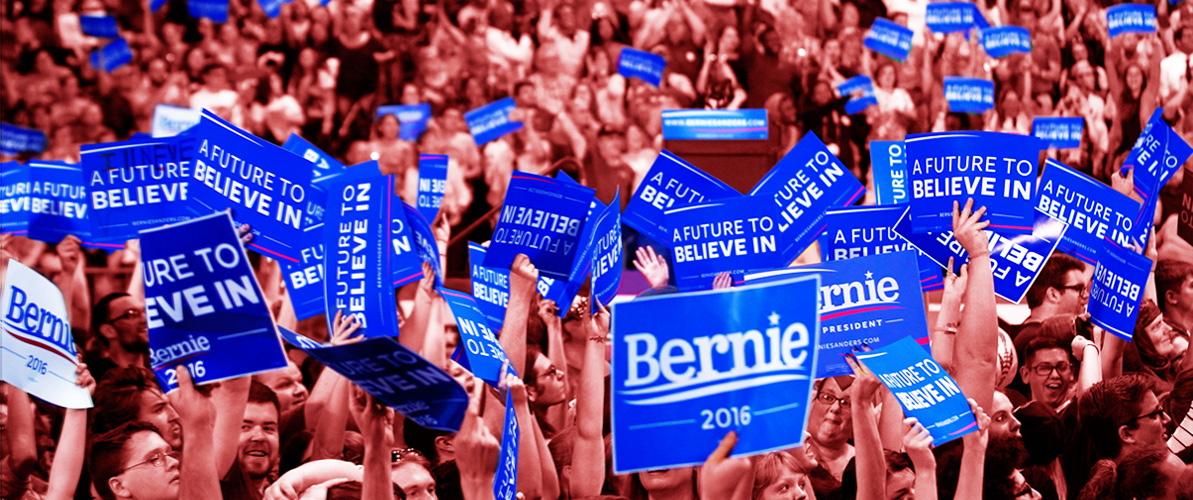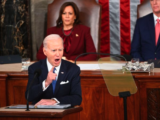
By Ethan Corey –
A YEAR AGO, WHEN BERNIE SANDERS ANNOUNCED HIS RUN FOR PRESIDENT, few thought his bid would amount to more than a protest campaign. But today, after more than 2 million donors and 400,000 volunteers have helped Sanders build a highly effective political organization that has earned him victories in 18 states so far, activists are strategizing about how to turn his campaign into a long-term movement.
In nearly every state in the nation, autonomous grassroots organizations began campaigning for Sanders months before his campaign established any official presence on the ground. Ranging from state-level organizations such as Illinois for Bernie and Team Bernie NY to city and even neighborhood groups, they brought together thousands of volunteers—many of whom had never participated in electoral politics—to work together toward a common goal.
Now, those organizations are beginning to build coalitions with labor, socialist parties and progressive groups to set a post-election agenda for the political revolution. To that end, National Nurses United, which endorsed Sanders, is organizing a People’s Summit on June 17 in Chicago, while the People’s Revolution, a group founded by former Occupy organizers, is hosting a People’s Convention in Philadelphia two days before the Democratic National Convention in July. As with any project to unite the Left, however, these efforts must first grapple with long-standing divides around tactics and priorities.
“The advantage of a presidential campaign is that it unifies competing interests around a common goal,” says Charles Lenchner, cofounder with Winnie Wong of People for Bernie, one of the largest pro-Sanders grassroots organizations and a partner in the People’s Summit. “Without a candidate to rally around, the contradictions become more visible.”
One of the biggest open questions is what role Sanders and his campaign infrastructure will play. On a number of occasions, Sanders has expressed his desire to continue fighting for political revolution, win or lose. Larry Cohen, former CWA president and senior adviser to the Sanders campaign, says that Sanders will continue to be a “transformational force” in American politics well beyond the election. The Sanders campaign recently began fundraising for three progressive insurgents who are challenging Democratic incumbents: Zephyr Teachout in New York, Lucy Flores in Nevada and Pramila Jayapal in Washington. The campaign also plans to support other down-ballot candidates, according to Cohen.
Cohen thinks that Sanders will also support grassroots efforts to further his political revolution. “His own support for it won’t be centralized, but more of a facilitating role within that network,” says Cohen. “That is a characteristic of how this campaign has operated from the start, and that’s not an accident.”
“We want Bernie to share what he built in large part thanks to our help. We want to make sure it goes back to the people.”
The People’s Revolution envisions “Bernie without the Bernie,” says Jack “Jackrabbit” Pollack, who in October cofounded the group with fellow Sanders organizer Shana East. “What Bernie has shown us is that you can actually rally people around a set of policies that are really all going in a positive direction.”
The People’s Revolution sees Sanders as a critical partner in building a broad issues-based progressive movement to ensure the promise of the campaign—“A Future to Believe In”—becomes a reality. At the People’s Convention, the group plans to develop and ratify a People’s Platform to present to the Democratic National Convention and set an agenda for the broader movement.
The People’s Revolution also hopes to convince Sanders to turn over the resources his campaign has amassed—money, voter data and an email database—to the grassroots. “We want Bernie to share what he built in large part thanks to our help,” Pollack says. “We want to make sure it goes back to the people.”
To that end, an unrelated group of more than 1,000 Sanders supporters recently signed an open letter, drafted by New York teacher and labor activist Erik Forman, calling on Sanders to devote his resources toward building a permanent organization.
While he declined to go into specifics, Cohen says these questions are on Sanders’ mind as well. “There’s been a recognition by Bernie that this is about supporters feeling like they own a chunk of this campaign. That’s what accounts for the number of donations, and more importantly the number of volunteer hours.”
But Charles Lenchner cautions against relying on the Sanders campaign for direction and support. “The lesson of People for Bernie has been that you don’t need those traditional gatekeepers to make a difference,” he says. “The early weakness of the Sanders campaign was its greatest strength. People had to figure out how to build the infrastructure of a political campaign by themselves. We were able to create a massive volunteer network with almost no money at all. We want to make it as difficult as possible for outside groups to co-opt the movement that’s united behind Bernie.”
Another obstacle, of course, is that not everyone on the Left is united behind Sanders. Critics from the movement for Black lives have argued that Sanders’ focus on economic issues fails to confront the racialized nature of American capitalism.
“For too long, economic justice movements have asked people from marginalized communities to bracket their identities for the sake of the cause,” says Jessica Pierce, national co-chair of the Black Youth Project 100 (BYP100). “It’s one thing to say, ‘This is the people’s movement,’ but who are those people and how are they coming together?” Pierce continues. “Inclusion has to be completely integrated into your organizational structure. If I’m not seeing anything in a platform that speaks to what I deal with every day as a Black person, then that’s telling me I don’t matter.”
Pierce says BYP100 has not yet been contacted by organizers of the Summit or the People’s Convention (both groups say they plan to reach out). Pierce sees strategic potential in such large-scale collaborations, but for BYP100, she says, the key question would be, “How does it help us advance our cause, too?”
Lenchner believes that addressing concerns like Pierce’s is vital to creating a sustainable long-term movement. “We need to be intentional about bringing new people into leadership positions in the movement,” he says. “One of the big challenges is that movements tend to be led by the first people who showed up. That’s not a good way to decide who leaders are. It also shouldn’t just be the people who can work the most, because they’re the ones who have enough privilege to be able to do so.”
Lenchner hopes to address such questions head-on at the People’s Summit in Chicago, as well as moving beyond the “silos” that progressives often work in. Democratic Socialists of America is joining People for Bernie and NNU in organizing the event, and they’ve brought in a diverse array of groups such as Progressive Democrats of America, People’s Action, United Students Against Sweatshops and 350.org.
The goal is to “use the opportunity of a political campaign to generate broad unity on the Left, while creating a space for people to act autonomously to pursue their own goals and interests,” Lenchner says.
“The lesson of People for Bernie has been that you don’t need those traditional gatekeepers to make a difference.”
One point of tension is the age-old question of whether to continue to engage in electoral politics. “For many of us, participation in electoral politics feels like an abusive relationship,” reads Erik Forman’s open letter to Sanders. “Many of us poured our hearts into the presidential bids of the Rainbow Coalition, or the long-shot campaigns of Ralph Nader and other Green Party candidates. Many of us turned out to put Obama in the White House. … All of these electoral campaigns left little behind but broken hearts.”
Pollack, however, argues that the Sanders campaign has shown that the Left can actually win elections and use them to build power. “My experience with the Left has been that we reject electoral politics, and we agitate and we lobby,” he says. “But today Bernie is illustrating the idea that an electoral insurgency can take place that can actually push our agenda forward.”
The People’s Revolution hopes to spark similar insurgencies in future races on every level of the political system. Toward that end, they are talking with Grassroots Select, a digital collective founded by Sanders supporters to channel resources and volunteers to candidates who share Sanders’ agenda. Pollack also points to Berniecrats.net, a crowdsourced list of more than 250 pro-Bernie candidates running in 2016, as another example of how Sanders’ grassroots support can buoy other progressive candidates.
Differences on strategy aside, however, Pollack thinks the most important goal is ensuring that the political revolution promised by the Sanders campaign doesn’t fade away. “People who didn’t believe they had anything to fight for suddenly realized that they weren’t alone,” he says. “We need to organize, we need to strategize and build power to make our ideas a reality.”
—
Originally published on the Website of In These Times.
ETHAN COREY is a New York-based reporter writing about politics, social movements and inequality.
Before you continue, I’d like to ask if you could support our independent journalism as we head into one of the most critical news periods of our time in 2024.
The New American Journal is deeply dedicated to uncovering the escalating threats to our democracy and holding those in power accountable. With a turbulent presidential race and the possibility of an even more extreme Trump presidency on the horizon, the need for independent, credible journalism that emphasizes the importance of the upcoming election for our nation and planet has never been greater.
However, a small group of billionaire owners control a significant portion of the information that reaches the public. We are different. We don’t have a billionaire owner or shareholders. Our journalism is created to serve the public interest, not to generate profit. Unlike much of the U.S. media, which often falls into the trap of false equivalence in the name of neutrality, we strive to highlight the lies of powerful individuals and institutions, showing how misinformation and demagoguery can harm democracy.
Our journalists provide context, investigate, and bring to light the critical stories of our time, from election integrity threats to the worsening climate crisis and complex international conflicts. As a news organization with a strong voice, we offer a unique, outsider perspective that is often missing in American media.
Thanks to our unique reader-supported model, you can access the New American journal without encountering a paywall. This is possible because of readers like you. Your support keeps us independent, free from external influences, and accessible to everyone, regardless of their ability to pay for news.
Please help if you can.
American journalists need your help more than ever as forces amass against the free press and democracy itself. We must not let the crypto-fascists and the AI bots take over.
See the latest GoFundMe campaign here.
Don't forget to listen to the new song and video.
Just because we are not featured on cable TV news talk shows, or TikTok videos, does not mean we are not getting out there in search engines and social media sites. We consistently get over a million hits a month.
Click to Advertise Here














